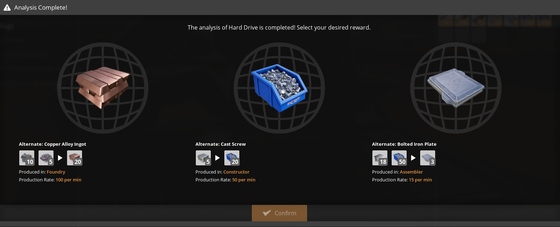Tutorial:Picking an alternate recipe
| Unfinished
This article is still under construction. |
Everyone plans their factories differently and thus has different conditions for choosing recipes.
Spoiler warning: There will be mentions of certain production lines which you might not have unlocked yet.
This page serves as a beginner guide for picking your first (or second, third...) alt recipe.
Overview
When exploring the world, you may occasionally stumble upon a Crash Site. Opening the nearby drop pod yields you a Hard Drive. Analysing the Hard Drive in the MAM presents you with a choice like this:
So now what? What are these Recipes even? And which one is the best choice?
Guide
Before we can make a choice, we need to know a few things about recipes:
- Every recipe has a unique name, but dont let that confuse you - Cast Screws are still just Screws.
- There are 114 crash sites, but only 85 alternate recipes. So no need to fear that you will miss out.
- You can unlock some alternate recipes before you can use them. Copper Alloy Ingot can be unlocked before you have Foundries.
Alright, now that we know that - we still cannot make a choice. We need to find out a way to judge these recipes.
Judging recipes
The preview you get in the MAM doesn't show you all the information. Click on a recipe to see the more data, such as 'items per minute' values.
First, lets look at: production speed
Copper Alloy Ingot, is faster than 'normal' Copper Ingot recipe in every way:
It takes 50 / min Copper Ore and makes 100 / min Copper Ingot.The cost of that extra speed and efficiency is Iron Ore.
So, in summary: Copper Alloy Ingot offers faster and greater Copper Ingot output at the cost of Iron Ore.
Next: simplified production
Cast Screw skips the Iron Rods production step when making screws. But what about resource efficiency?
The Iron Rod Recipe takes 1 Ingot to make 1 Rod. The Screw Recipe uses 1 Rod to make 4 Screws, so we turn 1 ingot into 4 screws.
Cast Screw turns 5 ingots into 20 screws. That sure is more, but is it better?
The resource efficiency is the important part here.
Divide Output by Input to get the production ratio. Bigger ratio = higher resource effiency.
The normal Screw recipe has a ratio of 4 (4 / 1). Cast Screw also has a ratio of 4 (20 / 5). So both recipes have the same efficiency*.
( *if you use the normal recipe for Iron Rods.)
Lastly, Bolted Iron Plate:
It is 3 times faster than the normal recipe for Reinforced Iron Plates, but:
- The Screw-to-Reinforced Plate Ratio is 0.06 (the normal recipe has 0.8333..)
- the Iron Plate-to-Reinforced Plate Ratio is 0.1666.. (same as the normal recipe)
So we now know that it is faster at the cost of more screws.
Besides these factors there are also a few others, such as the space used, power consumed or simply using different resources which might be closer to you.
Making a decision
Now that you know what these recipes do, you must decide which to pick.
This is where you have to judge yourself and your factories. There is no best overall choice, only the choice that is best for you.
Are you the type of person who is all about resource efficiency?
Do you just want to make stuff faster?
Do you have a production line that could be improved with one of these recipes?
If you still can't decide, then consider looking at other item pages to see if the recipe you are about to choose could become more useful or less useless in the future.
Maybe there is another alternate recipe that looks a lot more interesting to you.
One of the most important aspects of a recipe is how it interacts with other recipes. Some recipes are very limited in their use when used alone, but become stronger when combined with other recipes.
Tips and Tricks
- Experiment!
See also
| ||||||||||||||||||||||||||||||||

